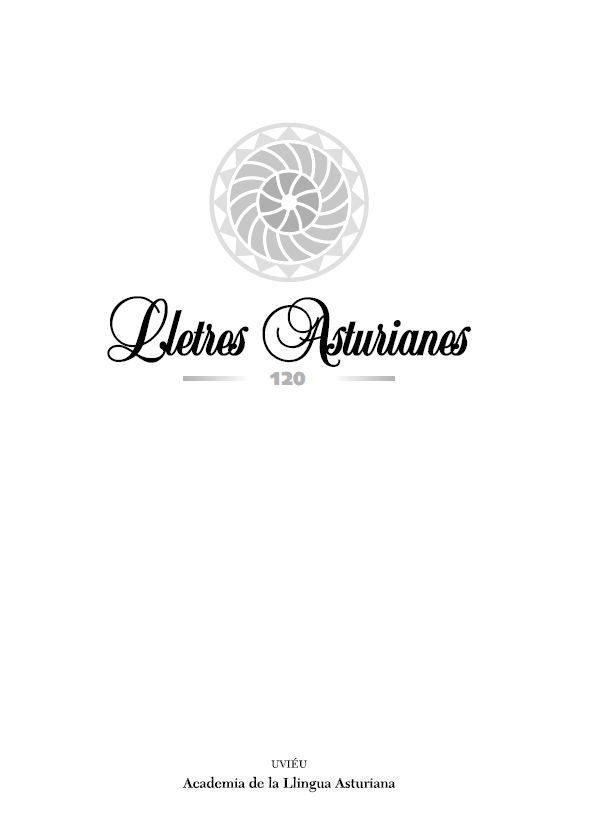Abstract
This paper emphasizes an idiosyncratic feature of Asturian within the context of other neighboring Iberian Romance languages. In all these languages, when the dative and the accusative clitic concur, a certain strategy is triggered that either fusions them or somehow modifies them, given that they are seen as identical at a certain level of analysis. In Asturian, however, datives remain the same in such a context. The paper explores the thesis that this state of affairs entailed the historical assimilation of properties of the locative clitic by the dative one. By means of this strategy, the dative clitic is able to be processed as sufficiently different from the the accusative. The paper makes a historical follow-up of the process, by means of the inspection of the Asturian medieval record and it identifies many instances of clitics in which the locative and the dative are almost indistinguishable. The claim is made that such a circumstance facilitated, on the one hand, the transfer of features in the locative-to-dative direction and, on the other hand, the imprinting of a distinct character onto the dative relatively to the accusative. The paper also deepens into a previously noted strategy, according to which the distinctiveness conflict between the accusative and the dative clitic was solved by means of a single contracted clitic. It is argued that the robustness of the hypothesis is sustained by its wide range of applications, both in similar and in completely independent cases, which points to the universal character of the grammatical constraint under investigation.
References
ACADEMIA DE LA LLINGUA ASTURIANA (2001): Gramática de la llingua asturiana. Uviéu, Academia de la Llingua Asturiana. [Tercera edición].
ALARCOS, Emilio (1960): «Miscelánea bable», en BIDEA XXXIX: 101-105.
ÁLVAREZ ARIAS, Celia y Miguel METZELTIN (eds.) (2008): Documentos orixinales del Monasteriu de San Vicente d’Uvieu I (1231-1238). Uviéu, Academia de la Llingua Asturiana.
ANDRÉS, Ramón d’(1993): Allugamientu de los pronomes átonos col verbu n’asturianu. Oviedo, Publicaciones del Departamento de Filología Española.
CAMACHO TABOADA, María Victoria (2002): «Sobre la formación de grupos clíticos románicos
en el componente postsintáctico», en Philologia Hispalensis 15: 21-41.
CHOMSKY, Noam (1995): The Minimalist Program. Cambridge (MA), MIT Press.
COLOMINA, M. Pilar (2016): La distintividad en la sintaxis. El caso de la combinación de clíticos en las lenguas iberorrománicas. [Universitat Autònoma de Barcelona, Trabajo Final
de Máster].
FERNÁNDEZ RUBIERA, Francisco J. (2010): «Force0
, Finiteness0 and the placement of clitics in
Western Iberian Romance language», en Estudos de Lingüística Galega 2: 77-95.
GARCÍA ARIAS, Xosé Lluis (1990): «¿Nueu referente de 3ª persona na llingua medieval», en Lletres Asturianes 36: 39-44.
– (2003): Gramática histórica de la lengua asturiana. Uviéu, Academia de la Llingua Asturiana.
– (2017): «Dos nuevos poemes del sieglu XVII», en Lletres Asturianes 116: 195-202.
GARCÍA SÁNCHEZ, Jesús (2016): Aportaciones a la cultura asturiana del siglo XVII. Manuscritos inéditos de los años 1665-1667. Dos poemas en asturiano. Oviedo, RIDEA.
GONZÁLEZ I PLANAS, Francesc (2002): «Sintaxis de los clíticos pronominales en asturleonés»,
en Ianua. Revista Philologica Romanica 7: 15-35.
HALLE, Morris y Alec MARANTZ (1993): «Distributed morphology and the pieces of inflection», en The View from Building 20. Ken Hale y Samuel Jay Keyser (eds.). Cambridge
(MA), MIT Press: 111- 176.
HILTY, Gerald (2010): «¿Existió, en la lengua del siglo XIII, un pronombre personal io/ia con
la misma función que ‘gelo/gela’?», en Ana Mª Cano (ed.), Homenaxe al profesor Xosé
Lluis García Arias. Uviéu, Academia de la Llingua Asturiana: 195-200.
JUNQUERA HUERGO, Juan (1869/1991): Gramática asturiana. [Entamu y notes de Xosé Lluis
Gracía Arias]. Uviéu, Academia de la Llingua Asturiana.
KAYNE, Richard (1994): The Antisymmetry of Syntax. Cambridge (MA), MIT Press.
LONGA, Víctor M., Guillermo LORENZO y Gemma RIGAU (1998): «Subject clitics and clitic recycling: locative sentences in some Iberian Romance languages», en Journal of Linguistics
: 125-164.
LORENZO, Guillermo (1994): «Clítico en asturiano medieval», en Lletres
Asturianes 53: 19-22.
– (1995): «La sintaxis de los clíticos del asturiano en el contexto de las lenguas romances»,
en Verba. Anuario Galego de Filoloxía 22: 191-227.
MEILÁN GARCÍA, Antonio (1988): «‘Y < IBI’ en castellano medieval: ¿sintagma o morfema?»,
en Verba 15: 421-432.
– (2007): «El adverbio Y (< IBI) del castellano medieval: su morfematización y translexematización», en Archivum 57: 197-218.
MENÉNDEZ GÓMEZ, Jesús (ed.) (2008): Documentos orixinales del dominiu llingüísticu ástur
I (1244-1299). Uviéu, Academia de la Llingua Asturiana.
MENÉNDEZ PIDAL, Ramón (1966): Documentos lingüísticos de España. Madrid, Anejo LXXXIV
de la RFE.
MIRANDA DUQUE, Andrea M. y Celia ÁLVAREZ ARIAS (eds.) (2008): Documentos orixinales
del Monesteriu de San Vicente d’Uviéu. II. (1239-1250). Uviéu, Academia de la Llingua Asturiana.
MEYER-LÜBKE, Wilhelm (1890-1906): Grammaire des langues romanes, vol. III. Paris, Welter.
NEIRA, Jesús (1976): El bable. Estructura e historia. Salinas, Ayalga.
RICHARDS, Norvin (2010): Uttering Trees. Cambridge (MA), MIT Press.
RIGAU, Gemma (1978): «Hi datiu inanimat», en Els Marges 12: 99-102.
SÁNCHEZ LANCIS, Carlos E. (1992): «El adverbio pronominal y como dativo inanimado en español medieval», en Actas del II Congreso Internacional de Historia de la Lengua Española. Tomo I. Madrid, Pabellón de España.
SÁNCHEZ VICENTE, Xuan Xosé y RUBIERA TUYA, Carlos (1985): «Enclisis, proclisis y pronomes átonos n’asturianu», en Lletres Asturianes 18: 71-81.
SUÁREZ FERNÁNDEZ, José (1990): «Los bloqueadores funcionales átonos», en Lletres Asturianes 35: 39-44.
TORREGO, Esther (1998): The Dependencies of Objects. Cambridge (MA), MIT Press

